In the lead-up to the 2020 Tokyo Olympic Games, Japan is embracing international visitors as never before; and the country is encouraging travellers to go beyond the popular destinations of Tokyo and Kyoto, to discover the country’s other islands and cities.
Well, if one ever needed an incentive to explore the verdant island of Kyushu, the southernmost of Japan’s main islands, then look no further than the Seven Stars; writes Andrew Forbes.
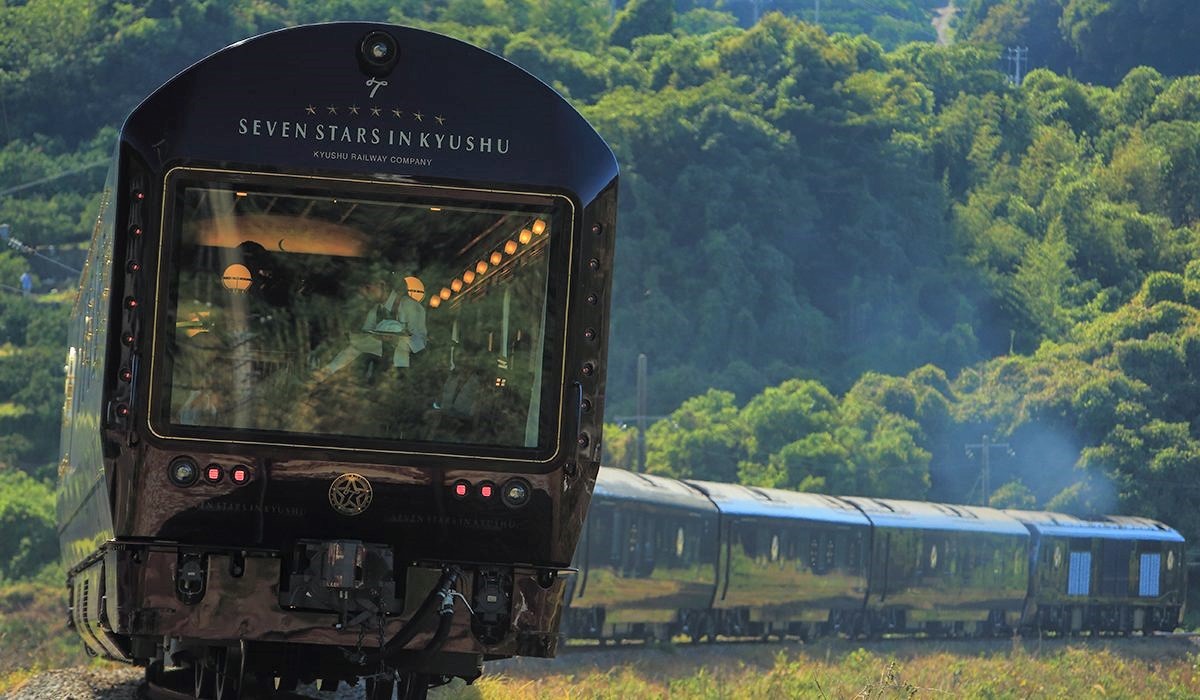
This gleaming, deep burgundy train, adorned with polished brass lettering has a timeless elegance akin to the world’s classic luxury sleeper trains, yet with quintessential Japanese style, from exquisite ‘kumiko’ wooden latticework; delicate paper shoji window screens; to elaborate meals prepared with typical Japanese attention to detail.
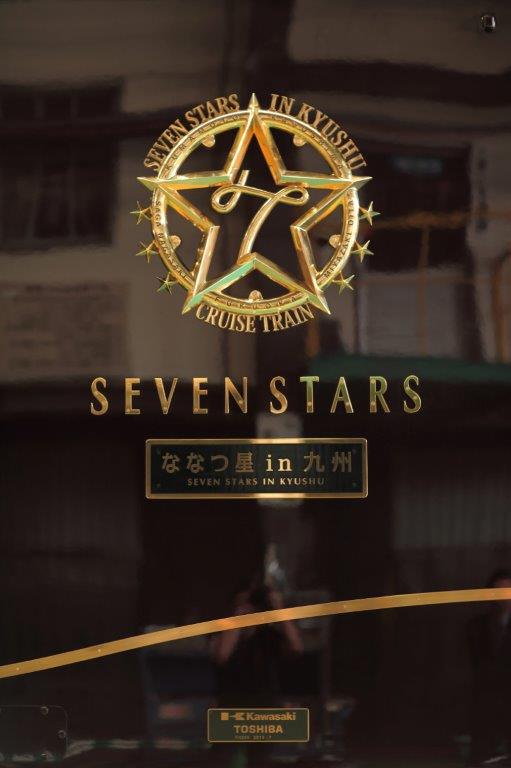
The Route
The Seven Stars train cruises the striking landscapes of Kyushu island, renowned for its stunning volcanic landscape of national parks and hot springs.
The Seven Stars train cruises the striking landscapes of Kyushu island…
Japan is made up of an extraordinary archipelago of hundreds of inhabited islands, extending more than 3,000 km from north to south, running through various climate zones. There are four main islands including Hokkaido in the north, Honshu (the main island where one finds Tokyo, Kyoto and Mt Fuji), Shikoku Island, and then Kyushu in the south.
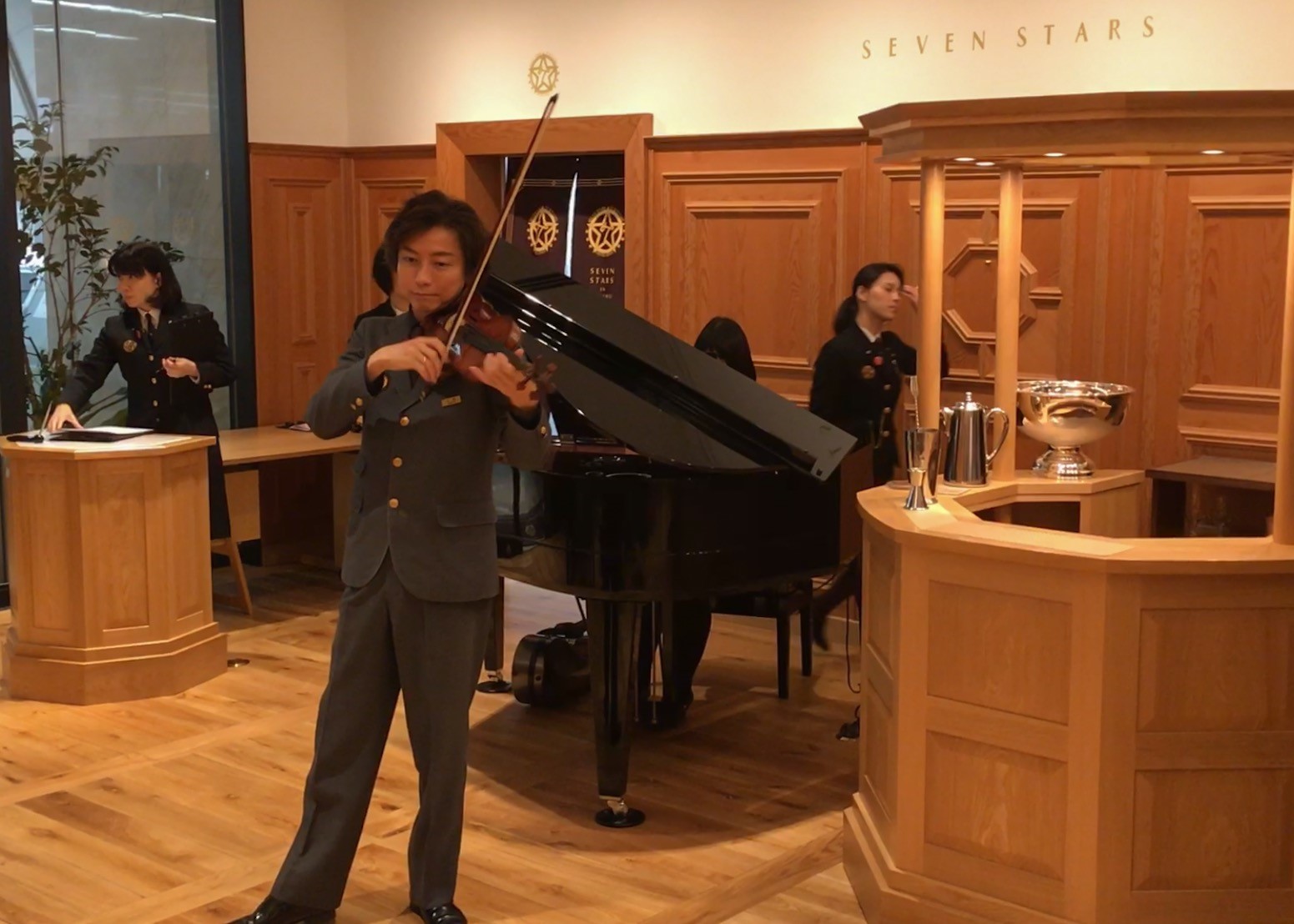
My Seven Stars experience began at the gleaming new Hakata station. My luggage, labelled with elegant tags with the gold star logo of the train, was taken aboard whilst I proceeded to the Seven Stars Kinsei departure lounge. One leaves behind the pristine glass, steel and marble atriums of the modern station and enters an exclusive club lounge filled with the gentle melodies of the pianist and violinist.
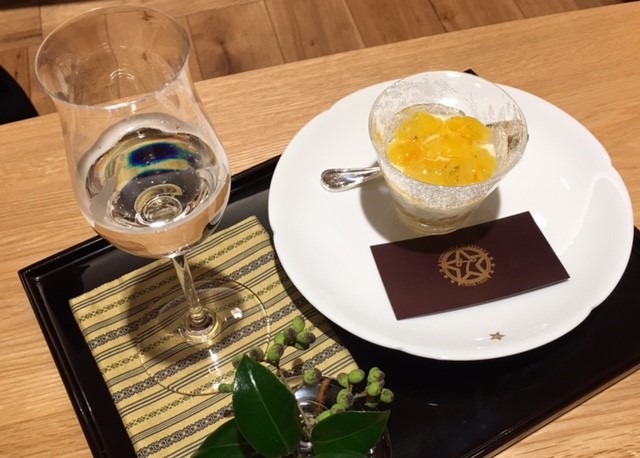
At my table, I am offered a chilled sparkling sake and mango mouse. The train manager greets us and then the musicians play the rousing anthem of the Seven Stars – it’s certainly begun to build into a sense of occasion, creating anticipation for the moment when we board the Seven Stars train.
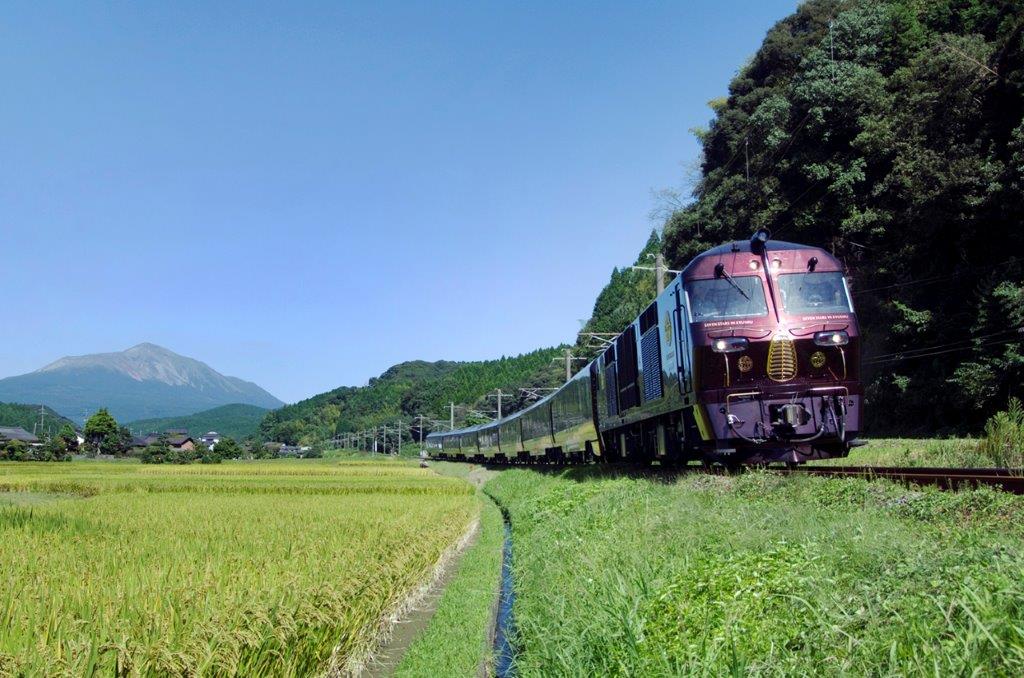
The Train
Although evoking nostalgia for a bygone era of luxury private train travel, the Seven Stars is very much a 21st-century creation. Launched in 2013, this purpose-built luxury cruiser was the idea of Koji Karaike, the boss of the Kyushu rail company which brought the Shinkansen bullet train to the island. His passion for Kyushu, and his desire to showcase the island to the world, led him in 2011 to commission the world’s most modern luxury sleeper train. Nothing would derail his focus, as within 2 years his dream was a reality.
The brief was to make the Seven Stars the best train in the world…
Every element of the design and construction of the train’s seven carriages was profoundly researched and considered by a specialist team led by industrial designer Eiji Mitooka. Here the focus wasn’t the legendary speed of Japan’s bullet trains, but the luxury and exclusivity of the world’s finest sleeper trains. The brief was to make the Seven Stars the best luxury train in the world and incorporate the wealth of artisan talent from Kysuhu.
Once finally aboard the train, it has immediate impact. Everything is immaculate – from the gleaming polished hardwood floors, and the rich wood-panelled walls to the engraved glass carriage doors. The uniformed crew move with almost choreographed finesse throughout the train – always smiling and frequently bowing.
As we pull away from the station, crowds of people along the platform enthusiastically wave; whilst on board the crew huddle around the windows waving back, encouraging us to do the same. It’s a childlike moment of excitement and joy that is to be repeated each time the train departs a station. In fact, the Seven Stars is an icon of considerable regional pride.

Each town along the route is honoured by the inclusion in the train’s itinerary and as we disembark at each destination, we are met by typical Japanese mascots, and treated as visiting dignitaries.
My cabin was ready and waiting for me, but first I headed to the lounge at the end of the train, evocatively called ‘Blue Moon’. Towards the lounge, one passes examples of Kyushu artisan fretwork. Created by Masato Kinoshita, one of Kyushu’s most famous woodworkers, these panels are really pieces of art – and a testament to the craftsmanship of Kyushu island.
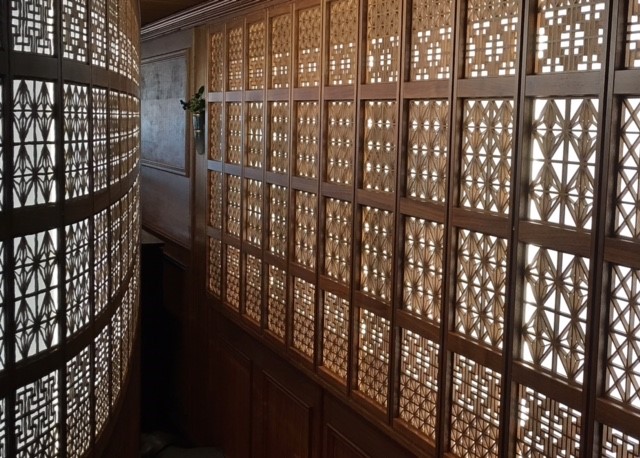
The entire end of the carriage is one large picture window, allowing you to experience luxury rail travel from a unique perspective.
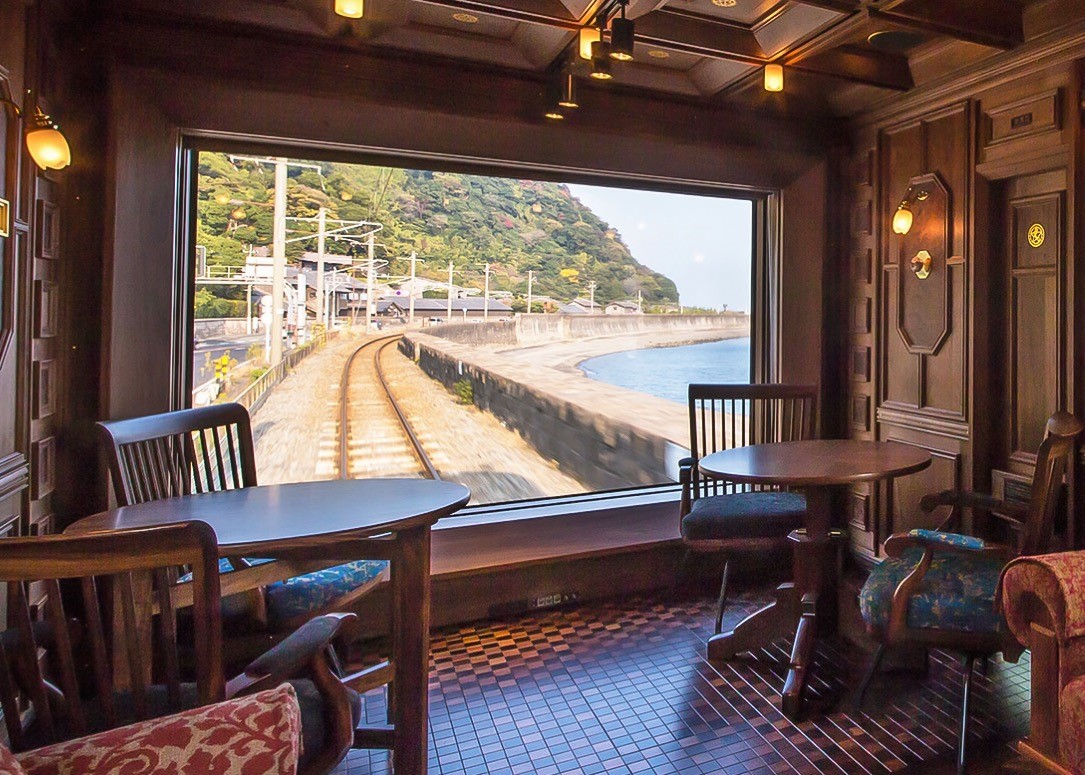
The crew are ever-attentive, and poured welcoming glasses of champagne before serving a generous brunch in the dining car.
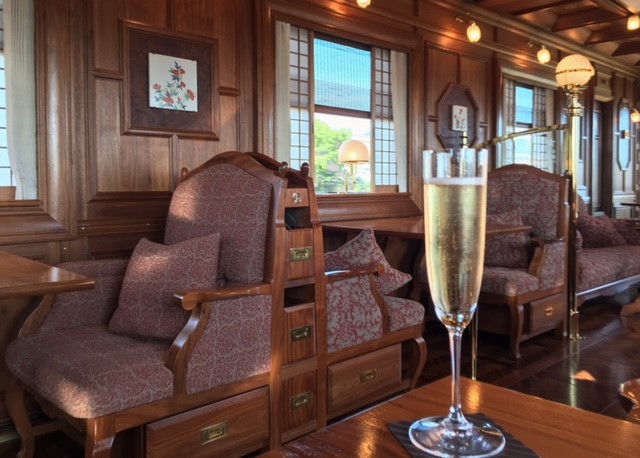
This isn’t the first time I’ve travelled in style on a private train, but this level of service and style takes luxury train travel to new heights.
Seven Stars may not have the heritage of say the Orient Express, but what this new train lacks in history is more than made up for with exceptional quality, service and exclusivity. I had guessed that the Seven Stars name referred to this the high of attentive service; yet it is in fact a reflection of the seven prefectures, or provinces, that make up the island of Kyushu. The island’s culture, cuisine and creativity is showcased on-board and during the excursions.
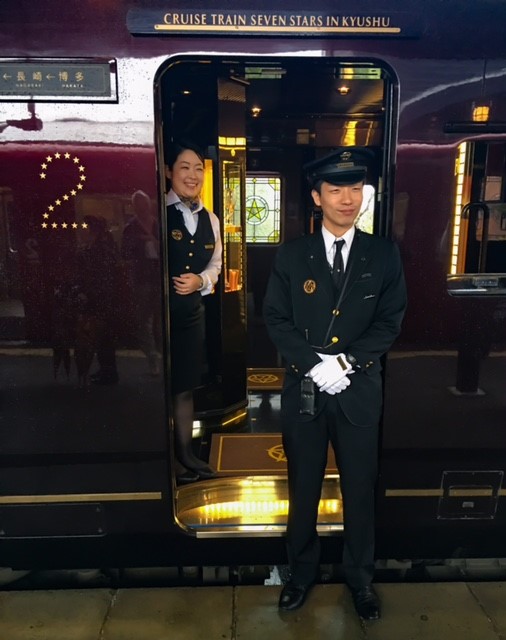
The Cabin
I was given suite 603, one of 12 refined cabins in the 5 sleeper cars. There are also two additional deluxe suites; number 702 which accommodates 3 people; and the largest, 701 right at the end of the train. When the locomotive is at the other end, guests in 701 can enjoy their private salon and from the sofa gaze out of the huge window.
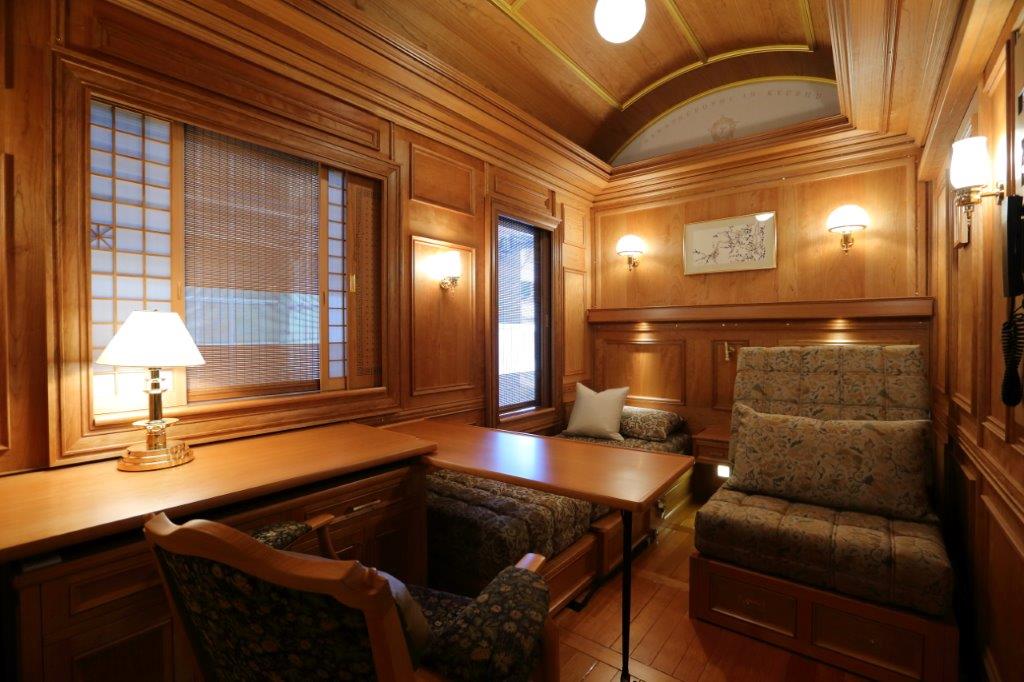
My suite is compact, at around 10 square metres, but thanks to a high ceiling and clever design, it feels comfortable. During the day, the twin beds are small sofas, and there is a desk that runs along one wall.
some additional, distinctly Japanese features…
The style is classic, nostalgic of the belle époque Pullman carriages of Europe, with radiant woodwork, brass fittings and vintage lights. Yet there were contemporary features such as A/C, telephone, mood lighting and some additional, distinctly Japanese features.
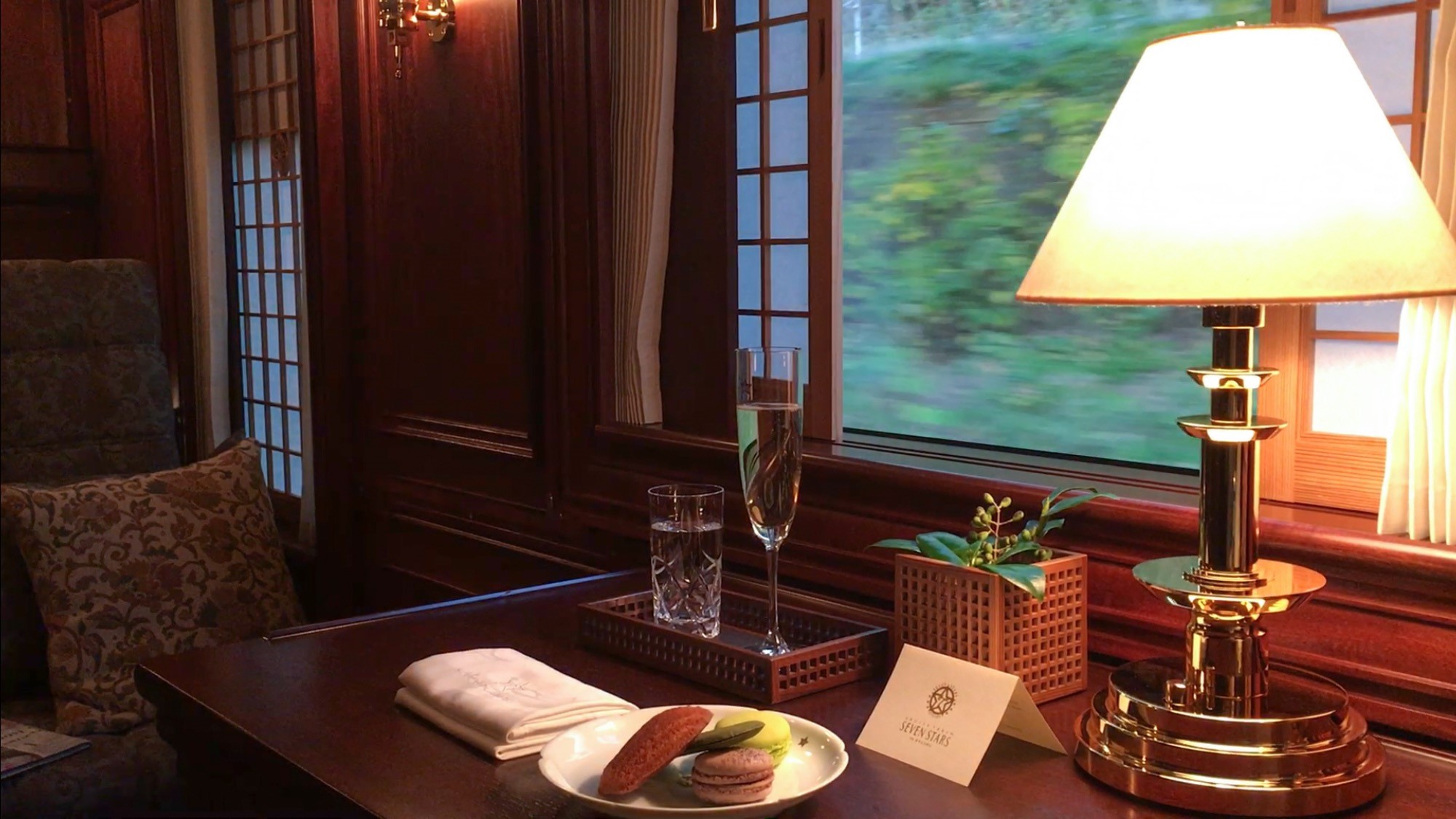
Firstly, the cabin has two different sized windows – one panoramic, the other tall and narrow, dressed with elegant bamboo blinds, delicate paper screens and wooden shutters. Once in the private ensuite shower room, there are more signature details, including a stunning handmade porcelain wash hand basin from the Kakiemon kiln – we were to visit the pottery on one of the excursions.
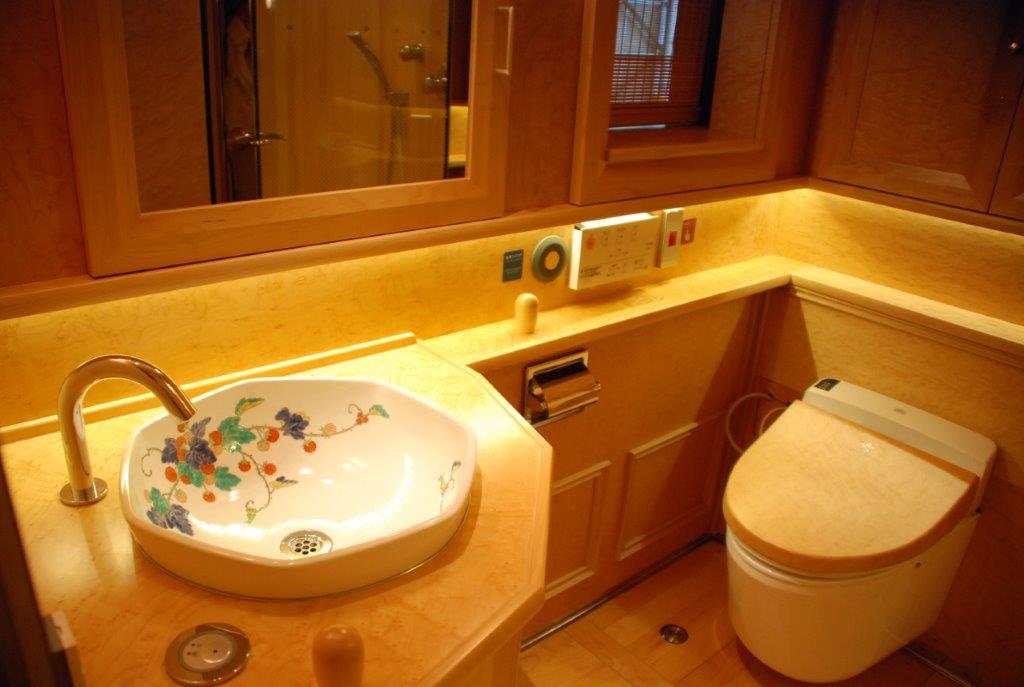
The ensuite was very well-appointed. Of course, there was an electronic Japanese bidet W.C., but also a full-size shower lined with Japanese hinoki cypress wood, together with a little cypress wooden stool. In a country where bathing is taken so very seriously, its unsurprising that the designers didn’t skimp in the shower room.
A Pandora’s box of bathroom amenities was left for me – opening it, revealed different-sized containers that fitted together like a puzzle – each containing a luxury amenity and of course the ubiquitous Japanese face and body cloth.
Whilst indulging at dinner expect one’s cabin to be prepared for the night. Aboard the Seven Stars which means that as well as having the bed made, there will be embroidered white pyjamas laid out for you too!
The bed is narrow – but relatively comfortable; and thankfully the train was in a secure siding during the night so there was no movement to disturb me, although it gently shuddered to life early the next morning. I think it would have been a treat to have a double bed in the cabin as one has on say the Transcantabrico train in Spain.
The Cuisine
Dining aboard the Seven Stars was without a doubt the best gastronomy that I’ve enjoyed on a luxury train. I shouldn’t have been surprised, since when I passed the galley kitchen on the way to the ‘Jupiter’ dining car, I clocked at least 5 chefs deftly negotiating the cramped space, each smartly attired in chefs’ whites.
The Japanese lunch commenced with a bento tray of bite-size starters – as much a visual feast as a culinary one.
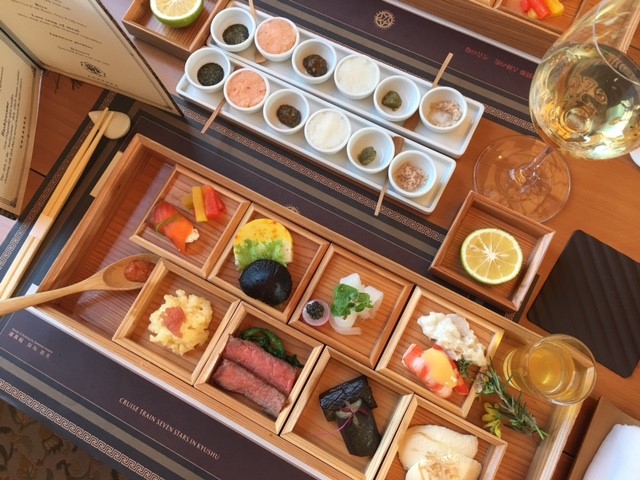
My advice is to pace yourself with eating – the food doesn’t stop coming. A few hours later expect delightful afternoon tea treats from the Patisserie Muguet by Ryuji Ikeda, an acclaimed Kyushu pastry chef. The choice is tempting; delicate, pastel-coloured macarons, green tea biscuits, hazelnut madeleines, and chocolate bonbons. I devour a ‘Pandora’ cake – a handmade chocolate sphere, that when gently opened for me by one of the uniformed waiters, reveals a smooth nutty filling made from Kyushu chestnuts, from Kumamoto.
As much a visual feast as a culinary one…
Dinner was a gala affair, and everyone dressed for the occasion. I was reticent at first to don my bow tie, but the atmosphere was superb and in retrospect, I’m pleased that the Seven Stars encourages a fairly strict dress code on the train; it certainly helps maintain the magic on-board.
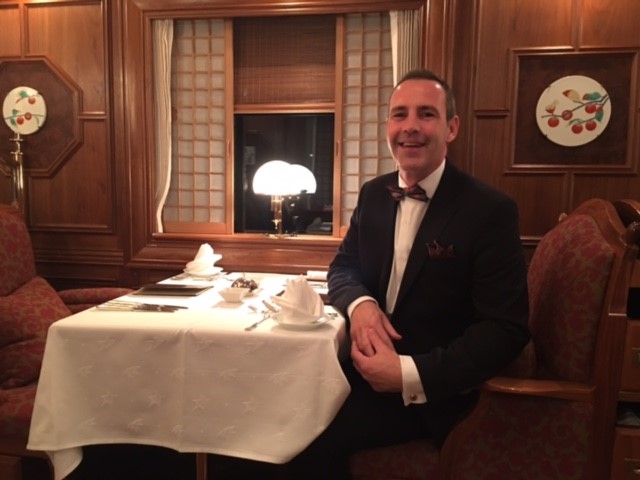
Chef Akara Kawabata had joined the train, to create the gourmet, seven course meal accompanied by champagne and Japanese wines and sake – we were clearly on track for a very special evening.
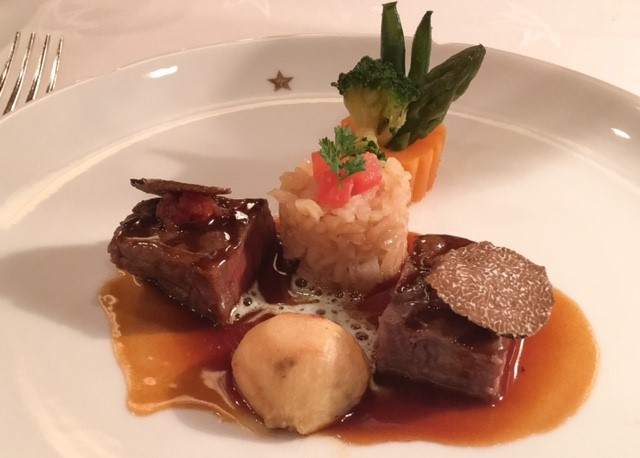
Cocktails at the bar accompanied by the pianist and violinist led into a gastronomic evening, that ended with an extraordinary performance by a musician who joined the train as we pulled into Nagasaki station.
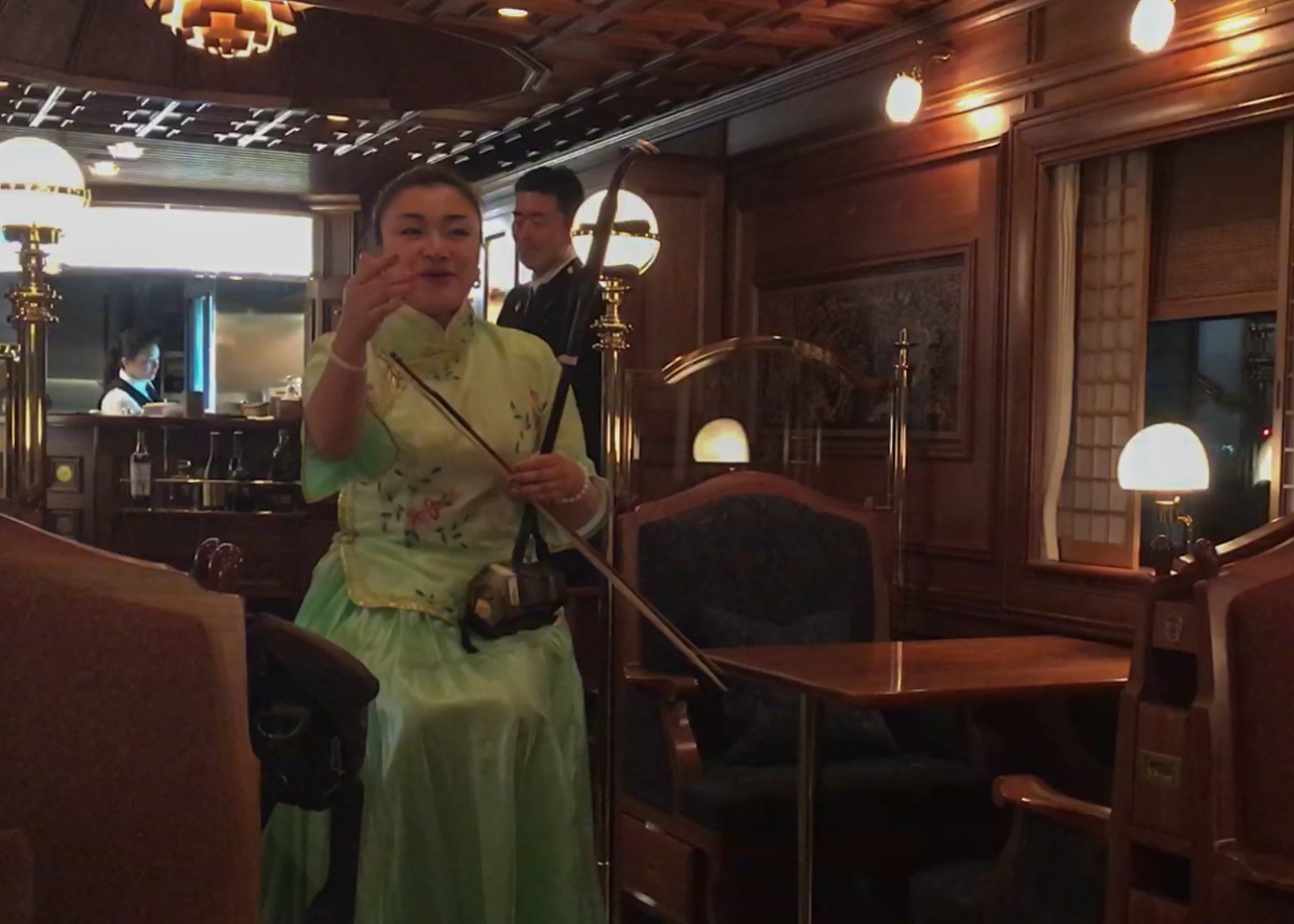
The musician wowed us a performance using a two-string bow called an ‘Er-hu’; it is known as a Chinese violin. But instead of being held horizontally from the shoulder, she held it vertically from her waist.
Breakfast was probably the most striking meal for me, as I opted to enjoy a traditional Japanese start to the day – an appetising tray of delicacies from Bungo, in the Oita prefecture, in the northeast of Kyushu.
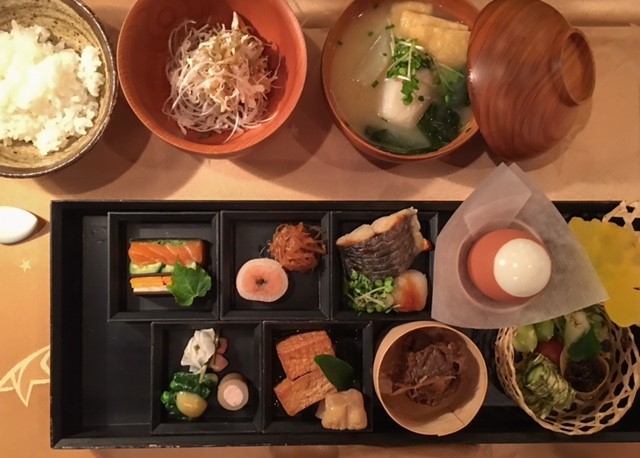
Small servings in tiny ebony boxes, bamboo cups and woven baskets included vegetables, pressed with salmon; a small rolled omelette; grilled mackerel; deep-fried tofu; miso soup; boiled beef; rice; pickles – and finally a precisely prepared boiled egg. What a beautiful start to the day!
The Excursions
In its bid to showcase the best of Kyushu, the train tour includes visits to cultural and natural highlights of the island. For example, the train stops at Arita for a guided visit to the prestigious Kakiemon pottery. The family are the pioneers of the famous over-glazed porcelain from the area. The visit included special behind-the-scenes access, as well as meeting with Kakiemon XV, the present artistic director, a direct descendent of Sakaida Kakiemo who created the family kiln in the 17th century.
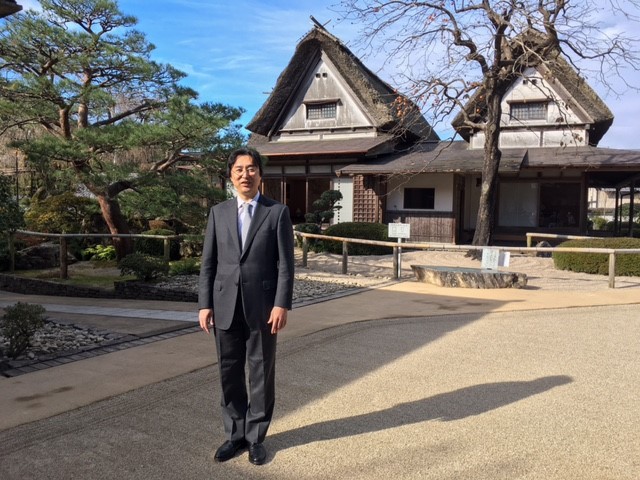

There is also an excursion to visit Lake Kinrin, offering quintessential Japanese scenes of maple trees overhanging the hot spring lake.
On the longer itinerary, there is a night’s stay at a classic country inn, or Ryokan, where guests can enjoy Kyushu’s famous hot springs.
Information
There are two main itineraries, of either 2 or 4 days, offering a unique way to enjoy the island, cruising some of its 3,000 km of track.
Prices for the 2-day, 1-night tour start from ¥480,000 (about £2,600)
Prices for the 4-day, 3-night tour start from ¥950,000 (about £5,200)




